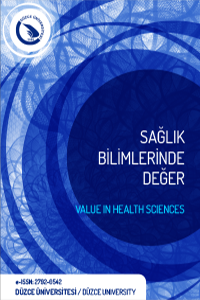Manyetik Rezonans Kontrast Ajanların Sıçan Beyni Üzerine Etkilerinin Histopatolojik Değerlendirilmesi
Manyetik rezonans kontrast ajan, gadoterik asit, gadodiamide, beyin
Histopathological Evaluation of the Effects of Magnetic Resonance Contrast Agents on the Rat Brain
magnetic resonance imaging, gadodiamide, gadoteric acid, brain,
___
- Caravan P, Ellison JJ, McMurry TJ, Lauffer RB. Gadolinium(III) chelates as MRI contrast agents: Structure, dynamics, and applications. Chem Rev. 1999; 99(9): 2293-352.
- Grobner T. Gadolinium - A specific trigger for the development of nephrogenic fibrosing dermopathy and nephrogenic systemic fibrosis? Nephrol Dial Transplant. 2006; 21(4): 1104-8.
- Frenzel T, Lengsfeld P, Schirmer H, Hütter J, Weinmann HJ. Stability of gadolinium-based magnetic resonance imaging contrast agents in human serum at 37°C. Invest Radiol. 2008; 43(12) :817-28.
- Kanda T, Ishii K, Kawaguchi H, Kitajima K, Takenaka D. High signal intensity in the dentate nucleus and globus pallidus on unenhanced T1-weighted MR images: Relationship with increasing cumulative dose of a gadoliniumbased contrast material. Radiology. 2014; 270(3): 834-41.
- Huang XX, Jiang RH, Xu XQ, Zu QQ, Wu FY, Liu S, et al. Ischemic Stroke Increased Gadolinium Deposition in the Brain and Aggravated Astrocyte Injury After Gadolinium-Based Contrast Agent Administration: Linear Versus Macrocyclic Agents. J Magn Reson Imaging. 2021; 53(4): 1282-92.
- Smith APL, Marino M, Roberts J, Crowder JM, Castle J, Lowery L, et al. Clearance of gadolinium from the brain with no pathologic effect after repeated administration of gadodiamide in healthy rats: An analytical and histologic study. Radiology. 2017; 282(3): 743-51.
- Robert P, Lehericy S, Grand S, Violas X, Fretellier N, Idee JM, et al. T1-Weighted Hypersignal in the Deep Cerebellar Nuclei after Repeated Administrations of Gadolinium-Based Contrast Agents in Healthy Rats: Difference between Linear and Macrocyclic Agents. Invest Radiol. 2015; 50(8): 473-80.
- Tedeschi E, Caranci F, Giordano F, Angelini V, Cocozza S, Brunetti A. Gadolinium retention in the body: what we know and what we can do. Radiol Medica. 2017; 122(8): 589-600.
- Ramalho J, Ramalho M. Gadolinium deposition and chronic toxicity. Magn Reson Imaging Clin N Am. 2017;
- Al-boukai A a, Al-kassimi F a, Ibrahim GF, Shaik S a. Prediction of pulmonary hypertension in patients with or without ınterstitial lung disease. Radiology. 2011; 260(3): 875-83.
- Olchowy C, Cebulski K, Lasecki M, Chaber R, Olchowy A, Kałwak K, et al. The presence of the gadolinium-based contrast agent depositions in the brain and symptoms of gadolinium neurotoxicity-A systematic review. PLoS One. 2017; 12(2): 1-14.
- Abnormalities I, Mcdonald RJ, Mcdonald JS, Kallmes DF, Jentoft ME, Paolini MA, et al. Gadolinium deposition in human brain tissues after contrast-enhanced mr ımaging in adult patients without. Radiology. 2017; 000(0): 1-9.
- Öner AY, Barutcu B, Aykol Ş, Tali ET. Intrathecal Contrast-enhanced magnetic resonance ımaging-related brain signal changes: residual gadolinium deposition? Invest Radiol. 2017; 52(4): 195-7.
- Lenkinski RE. Gadolinium retention and deposition revisited: how the chemical properties of gadolinium-based contrast agents and the use of animal models ınform us about the behavior of these agents in the human brain. Radiology. 2017; 285(3): 721-4.
- McDonald RJ, McDonald JS, Kallmes DF, Jentoft ME, Murray DL, Thielen KR, et al. Intracranial gadolinium deposition after contrast-enhanced MR imaging. Radiology. 2015; 275(3): 772-82.
- Murata N, Gonzalez-Cuyar LF, Murata K, Fligner C, Dills R, Hippe D, et al. Macrocyclic and other non-group 1 gadolinium contrast agents deposit low levels of gadolinium in brain and bone tissue: Preliminary results from 9 patients with normal renal function. Invest Radiol. 2016; 51(7): 447-53.
- Jost G, Lenhard DC, Sieber MA, Lohrke J, Frenzel T, Pietsch H. Signal increase on unenhanced T1-weighted images in the rat brain after repeated, extended doses of gadolinium-based contrast agents comparison of linear and macrocyclic agents. Invest Radiol. 2016; 51(2): 83-9.
- Mamourian AC, Hoopes PJ, Lewis LD. Visualization of intravenously administered contrast material in the CSF on fluid-attenuated inversion-recovery MR images: An in vitro and animal- model investigation. Am J Neuroradiol. 2000; 21(1): 105-11.
- Taoka T, Naganawa S. Gadolinium-based contrast media, cerebrospinal fluid and the glymphatic system: Possible mechanisms for the deposition of gadolinium in the brain. Magn Reson Med Sci. 2018; 17(2): 111-9.
- Aime S, Caravan P. Biodistribution of gadolinium-based contrast agents, including gadolinium deposition. J Magn Reson Imaging. 2009; 30(6): 1259-67.
- Feng XD, Xia Q, Yuan L, Huang HF, Yang X Da, Wang K. Gadolinium triggers unfolded protein responses (UPRs) in primary cultured rat cortical astrocytes via promotion of an influx of extracellular Ca 2+. Cell Biol Toxicol. 2011; 27(1): 1-12.
- Yayın Aralığı: Yılda 3 Sayı
- Başlangıç: 2022
- Yayıncı: Düzce Üniversitesi
Fokal Asimetrik Meme Dansitelerinin Değerlendirilmesinde Tomosentezin Tanıya Katkısı
Derya GÜÇLÜ, İbrahim Feyyaz NALDEMİR, Elif Nisa UNLU, Ömer ÖNBAŞ
Fatih DAVRAN, Ceyhan HACIOĞLU, Merve ALPAY, Pınar YILDIZ GÜLHAN, Cihadiye Elif ÖZTÜRK, Nevin INCE, Elif Nisa UNLU, Ali ANNAKKAYA
Adem KOYUNCU, Davut SARI, Gülden SARI, Cebrail ŞİMŞEK, Ünal AKEL
Post Kolesistektomi Sendromu: Kırk Sekiz Yaşında Kadın Hastada Kolon Kanseri Olgu Sunumu
Hasan Can DEMİRKAYA, İsmet ÖZAYDIN, Mehmet Emin GÖNÜLLÜ, Nurgül ALTINSOY
COVID-19’a Bağlı Sitokin Fırtınasında Anakinra ve Tosilizumab Tedavilerinin Karşılaştırılması
Ali AKIN, Yılmaz SAFİ, Talat Soner YILMAZ
Helicobacter pylori Eradikasyonunda Kullanılan Kombine Tedavilerin Etkinliklerinin Karşılaştırılması
Gulsah ALTUN, Türkay AKBAŞ, Dilek YEKENKURUL
Eczacılık Mesleğinde Yönetim Eğitimi
